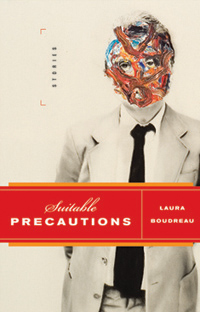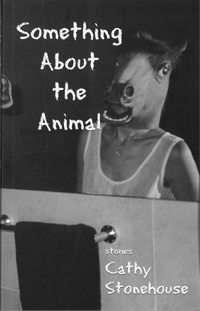Reviews
Fiction Review by Sandra McIntyre
Laura Boudreau, Suitable Precautions (Emeryville: Biblioasis, 2011). Paperbound, 192 pp., $19.95.
Cathy Stonehouse, Something About the Animal (Emeryville: Biblioasis, 2011). Paperbound, 224 pp., $19.95.
The characters in Laura Boudreau’s debut short story collection take
precautions  against a variety of outcomes—the discovery of secrets,
memory loss, loss of innocence, payback, vulnerability, danger. Often,
the precautions seem elaborate and twisted. In “Strange Pilgrims,”
Ella does “something that disgusted her” every day, such as smoking
a cigarette butt off the ground, to counter the beauty and ease of her
post-windfall life. In “The Dead Dad Game,” Nate and Elaine make a
game of what they don’t understand, competing for the better death
through the details of dying, while mom Natalie attempts to ward off
the pain of loss through remembrance rituals. These extreme measures
allow Boudreau some latitude in drawing and developing her characters.
As a result, the stories in Suitable Precautions are peopled with
characters who act in believably quirky and compellingly odd ways.
In reading Boudreau’s stories we come to see that the characters in
fact choose precautions that are appropriate to who they are, how they
perceive the world, and what they want. The precautions develop and
reveal character in turn. In “The D and D Report,” Alexa will let nothing
stand in the way of her ambitions. She cuts a friend loose as a precaution
against her big lie being discovered—or perhaps against being
reminded of the lie as she proceeds to build her life on it. Alexa’s precautions
and the outcomes upon which they are predicated tell us
much about who she is.
against a variety of outcomes—the discovery of secrets,
memory loss, loss of innocence, payback, vulnerability, danger. Often,
the precautions seem elaborate and twisted. In “Strange Pilgrims,”
Ella does “something that disgusted her” every day, such as smoking
a cigarette butt off the ground, to counter the beauty and ease of her
post-windfall life. In “The Dead Dad Game,” Nate and Elaine make a
game of what they don’t understand, competing for the better death
through the details of dying, while mom Natalie attempts to ward off
the pain of loss through remembrance rituals. These extreme measures
allow Boudreau some latitude in drawing and developing her characters.
As a result, the stories in Suitable Precautions are peopled with
characters who act in believably quirky and compellingly odd ways.
In reading Boudreau’s stories we come to see that the characters in
fact choose precautions that are appropriate to who they are, how they
perceive the world, and what they want. The precautions develop and
reveal character in turn. In “The D and D Report,” Alexa will let nothing
stand in the way of her ambitions. She cuts a friend loose as a precaution
against her big lie being discovered—or perhaps against being
reminded of the lie as she proceeds to build her life on it. Alexa’s precautions
and the outcomes upon which they are predicated tell us
much about who she is.
Boudreau skilfully handles her characters’ awareness of their
preparatory actions and what those actions may cost them; many stories
end with these moments of understanding. “Nothing just disappears,”
Alexa says at the close of “The D and D Report”—not secrets or
friendships or money. How pleasurable it is as a reader to acquire this
same understanding through the story, and not have to be told by the
narrator or through a more obvious revelation. In “Tick,” one of the
strongest and most dramatic stories, Boudreau uses second-person
narration to shift this moment of awareness onto the reader directly.
By the time we realize we are in danger and have not taken suitable
safeguards against the force of her narration, it is too late. Just because
some precautions are suitable doesn’t mean they are effectual. In “The
Meteorite Hunter,” Julia tries to protect Diana from the difficulty of
attending a funeral by sending her on the road with her dad, David,
only to have her brought closer to death than anyone could have foreseen.
Despite Julia and David’s precautions, Diana is literally brought
face to face with death. Some outcomes are unavoidable.
Boudreau seems to enjoy writing about attempts and effort, as
opposed to outcome. It’s the game not the winner, the race not the finish
that interests her. And while the characters are busy bringing balance,
countering effects, warding, protecting and otherwise preparing,
their lives continue to happen. From growing up to falling in love,
good luck to tragedy, Boudreau’s precautionary tales show us that in
the randomness of life, prevention is not always possible. How can
you take suitable precautions when outcomes are unknowable? Not
surprisingly, the only sure outcome—death—is a common thread in
these stories, though accidents, mishaps, misunderstandings, and mistakes
also abound. Often, as in “The Dead Dad Game” and “The Vosmak
Genealogy,” an object of love (the dad and Mickey, and the
daughter, respectively) is cared for deeply and unabashedly as protection
against the inevitability of loss. For Boudreau, it seems love is the
most powerful precaution, and as such is the only one that comes with
any sort of guarantee.
Cathy Stonehouse’s Something About the Animal is another debut short
story  collection from Biblioasis, though strikingly different from
Boudreau’s. Stonehouse writes in or on the edge of crisis, often about
characters that have only a tenuous sense of control or a slippery grip
on reality. These unstable characters—would-be suicides, agoraphobics,
runaways, rape victims, post-partum-depression and PTSD sufferers—
live difficult, double lives of profound uncertainty alongside
day-to-day routine. Some of them, like Jackie in “Going to India,” who
muses about “what she’ll say from her straitjacket, when they come,”
and the first-person narrator of “Where I Live Now,” who waits
patiently for someone to “cart me away and lock me up,” are perfectly
aware of how close they are to the edge. Others, like Beryl in “Beryl
Takes a Knife,” are not so lucid: she thinks the paramedic who has
come to take her away is her lost son, and she welcomes him with
open arms.
collection from Biblioasis, though strikingly different from
Boudreau’s. Stonehouse writes in or on the edge of crisis, often about
characters that have only a tenuous sense of control or a slippery grip
on reality. These unstable characters—would-be suicides, agoraphobics,
runaways, rape victims, post-partum-depression and PTSD sufferers—
live difficult, double lives of profound uncertainty alongside
day-to-day routine. Some of them, like Jackie in “Going to India,” who
muses about “what she’ll say from her straitjacket, when they come,”
and the first-person narrator of “Where I Live Now,” who waits
patiently for someone to “cart me away and lock me up,” are perfectly
aware of how close they are to the edge. Others, like Beryl in “Beryl
Takes a Knife,” are not so lucid: she thinks the paramedic who has
come to take her away is her lost son, and she welcomes him with
open arms.
Stonehouse’s skill lies in her ability to render a topsy-turvy world
without alienating her reader. Her writing is disarming and fearless,
never cute or sweet. Even stories that are light in tone, such as “A Special
Sound” and “Child Abuse,” reveal an underbelly that is grave,
bordering on bleak. (After all, how light can a story called “Child
Abuse” be?) Especially interested in the vulnerability of the poor and
the poorly loved, Stonehouse gives girls in trouble recurring roles in
her wide cast. In stories like “The Stockholm Syndrome,” “Salt and
Clay,” and “A Little Winter” female characters collide with or try to
escape the fathers, boyfriends, husbands, and random men who can
hurt them. And hurt them they do—beating, berating, forcibly confining,
raping, even murdering. These girls need protectors, mentors,
and friends, but of these there are few. For the most part, they make
their way alone and ill-equipped.
In the midst of so much violence the odd story surprises with its
optimism. In “Underneath the World,” Cynthia and Jude are two single
mothers doing the best they can, failing in minor ways. Together,
the women can perhaps lead happier, less jangled lives. The absence of
men in this story is noticeable and may have something to do with
the shades of hope we find there. In “Where I Live Now,” the presence
of men again signals trouble, as the damage done in an abusive fatherson
relationship is measured against the healthiness and hopefulness
of a homosexual one.
The violence, pain, and vulnerability Stonehouse seems drawn to creatively make for intense reading, yet an ease with shifts in time, a mastery of suspense, and perfect, revealing last lines soften the blows. Like the sounds of the girl’s prostitute mother with her lover in the title story, the stories in Something About the Animal are “both beautiful and dreadful,” but only in the title story does Stonehouse find the perfect balance between the two.
—Sandra McIntyre









